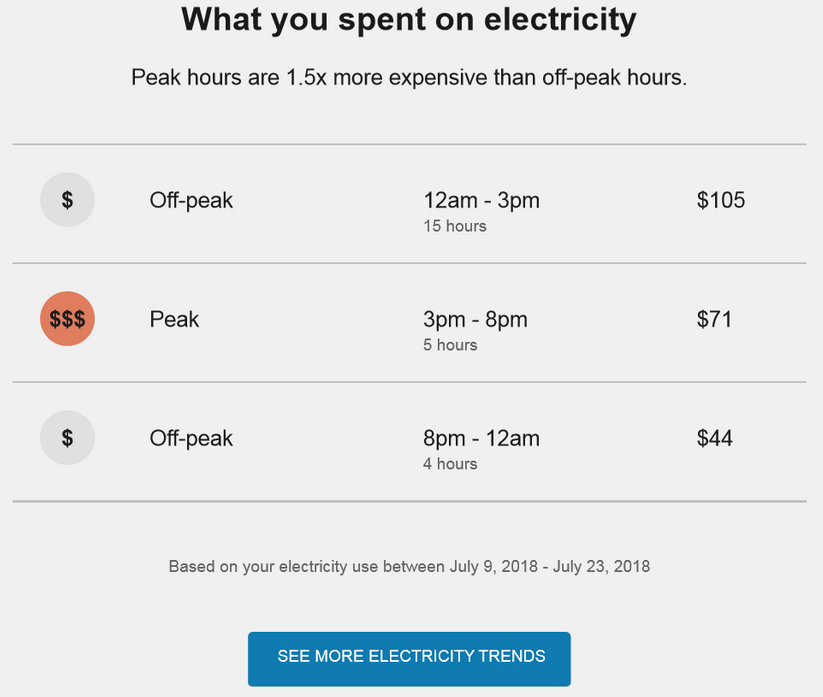BLS High Usage Module
This module shows customers how much money they spent on off-peak and on-peak hours over a specific time frame, encouraging them to shift their energy usage to off-peak hours.
Note that dual fuel customers might receive the dual fuel High Bill Alert AMI email that contains the BLS High Usage Period module and the standard High Usage Period module. The BLS High Usage Period module shows electric usage and the different pricing periods through the day that are associated with the electric TOU or demand rate plan. The standard High Usage Period module shows a single price for the day and displays gas usage.
Notes:
-
This section describes only the BLS High Usage Period module and does not cover additional modules that are delivered within the High Bill Alert AMI Email communication. See the Oracle Utilities Opower Proactive Alerts Cloud Service Product Overview for more information about the other modules.
-
This module is considered a legacy version. Before using this, be aware that Oracle recommends using the TOU HBA Main Insight module instead. While this module is still available, utilities starting a new deployment should use the TOU HBA Main Insight module, and utilities currently using the BLS High Usage Module are encouraged to upgrade to the TOU HBA Main Insight module. Contact your delivery team if you have questions about which module to use.
User Experience
This section describes the cost user experience for the BLS High Usage module.
This image shows an example of the BLS High Usage module:

Module Title: The title directs the customer's attention to how much they spent on electricity.
Insight Statement: The statement below the module title indicates how much more expensive energy is during peak hours compared to off-peak hours. For example, the statement might say, "Peak hours are 1.5x more expensive than off peak hours."
Peak and Off-Peak Usage Table: This table displays a row for each period during the day, and identifies the following:
- Whether the period is a peak, partial-peak, or off-peak period
- Which hours the period covers
- How many hours are in the period
- Expected cost for energy used during that period
The table also highlights peak and partial-peak periods using different color icons to draw attention to how much the customer is spending during peak hours.
Date Range Statement: This statement identifies the date range that is used to determine the information in the usage table.
See More Electricity Trends: Clicking this button takes customers to a specified site with additional information. The utility customer can configure this button to direct the customer to a site of their choosing. If available, the button should direct customers to the Data Browser in the Digital Self Service - Energy Management Web Portal. The customer is then prompted to sign into their account, or to register an account if they have not previously done so.
User Experience Variations
This section discusses user experience variations for the BLS High Usage module.
Use vs. Cost Variations
If the module is configured to display usage, the module shows the percentage of use during each period. If the module is configured to show cost, the module shows dollar amounts spent during each period.

Tiered TOU Rates
For customers on tiered TOU rate plans, the tier with the highest price ratio is used to determine the price ratio in the insight statement of the BLS High Usage Period module.
Partial-Peak Periods
For customers with rate plans that include partial-peak periods, the module displays off-peak, partial-peak, and peak hours using different color icons within the table.

Multiple Peak Periods
For customers with rate plans that include multiple peak periods each day, the module displays all peak periods in the table.

Weekday and Weekend Breakdowns
If a customer’s rate plan has different weekday and weekend pricing breakdowns, then the BLS Time of Day modules should be separated so that the weekday module is displayed first and the weekend module appears next.
Insight Statement: The statement that appears below the module heading changes as follows, depending on whether the module is displaying weekday or weekend data:
- On weekdays, peak hours are 1.5x more expensive than off-peak hours.
- On weekends, peak hours are 1.3x more expensive than off-peak hours.
In some scenarios, the price ratio can be the same on weekdays and weekends, but there will still be two charts displayed if the peak period times are different on weekdays and weekends.
Footer: The footer statement reads: "Based on your electricity use between [date range]."
This example illustrates different price ratios on weekdays and weekends:

If the rate plan has peak hours during the week, but no peak hours on the weekend, the module appears as follows, and no weekend chart is displayed, as shown here:
